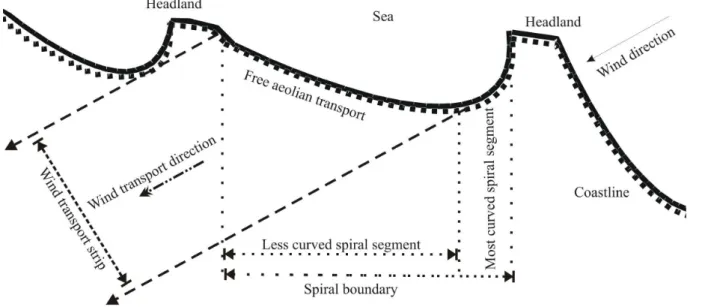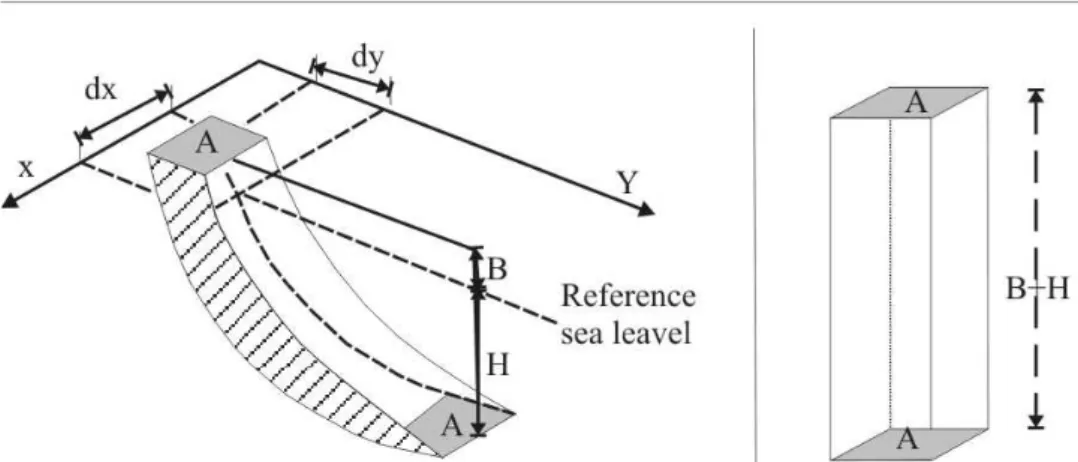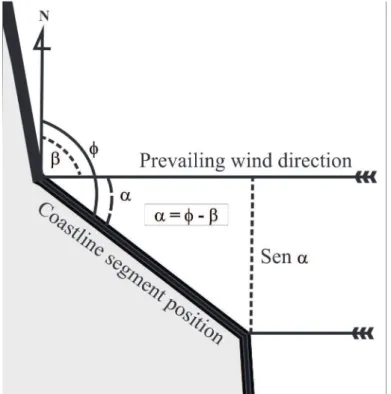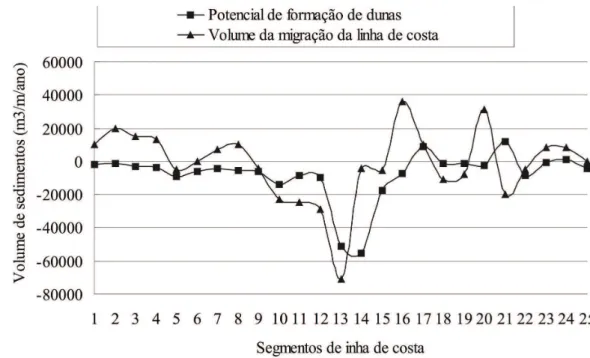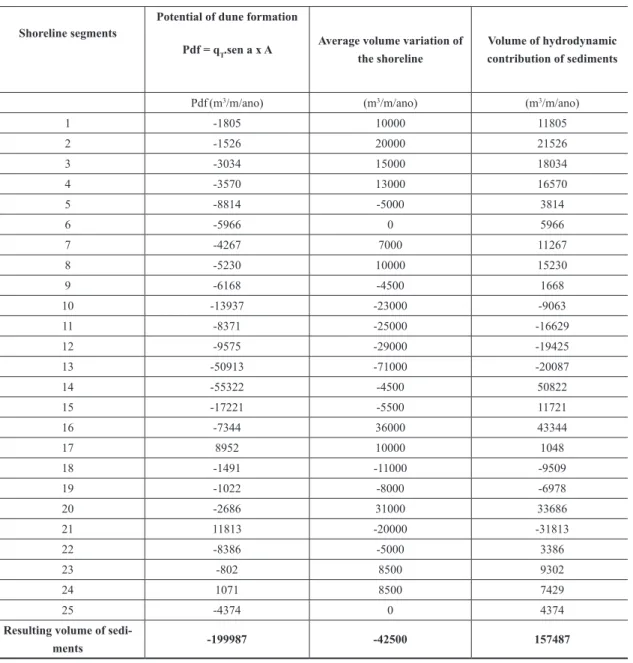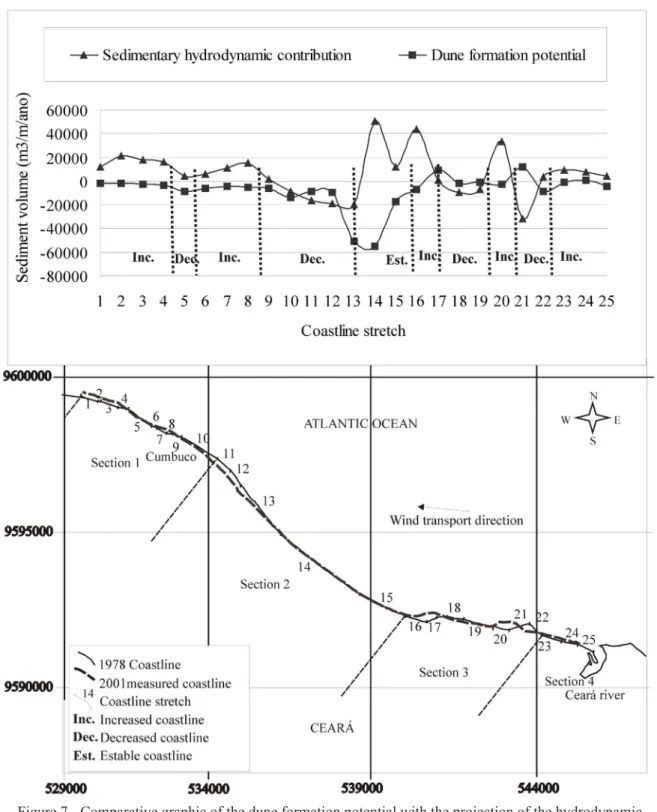THE WIND TRANSPORT CONTRIBUTION
IN THE PROCESS OF SHORELINE EVOLUTION
contribuição do transporte eólico no processo de evolução da linha de costa
Alexandre Medeiros de Carvalho *
Vanda de Claudino Sales **
Resumo
Este trabalho avalia a importância do transporte eólico para o comportamento morfogenético de um trecho de 20Km da costa cearense entre a desembocadura do Rio Ceará e a Praia do Cumbuco. Consistiu na com-paração entre o volume de areia envolvido na migração da linha da costa entre 1974 e 2001 e o potencial de formação de dunas, que é baseado na relação entre o ângulo formado entre a posição da linha de costa e a direção dominante do transporte eólico. O volume de material resultante da migração da linha de costa foi calculado multiplicando-se a área acrescida ou retirada pela soma da altura da berma ativa e a profundidade de fechamento. O potencial de formação de dunas, calculado para cada segmento estudado, demonstrou: (1) guardar uma excelente correlação com os volumes medidos para a migração da linha de costa; e (2) que a maioria dos segmentos têm sido submetidos a um potencial déicit sedimentar provocado pelo vento, salvo alguns poucos trechos onde há uma tendência de realimentação da praia pelo transporte eólico, através de um processo de ‘headland bypass dune’. Os resultados mostraram que a atividade eólica pode ser funda-mental para o equilíbrio da linha de costa, reforçando, desta forma, a idéia de que os trabalhos envolvendo a dinâmica costeira necessitam do estudo do transporte eólico para que possam representar adequadamente a dinâmica costeira da região estudada.
Palavras-chave: Potencial de formação de dunas; Migração da linha de costa; Morfodinânica costeira. Abstract
This paper evaluates the eolian transport importance for the morphological behavior of a 20 Km stretch on the coast of Ceará between the Ceará river mouth and the Cumbuco Beach. The research consisted of the comparison between the sand volume involved in the coastline migration between 1974 and 2001 and the dune formation potential that is based on the relationship developed by the formed angle between the coas-tline position and the eolian transport dominant direction. The resulting material volume from the coascoas-tline migration was calculated by multiplying the advanced or retreated area by the sum of the active berm height and the closing depth. The dune formation potential, calculated for each studied segment, demonstrated (1) to keep an excellent correlation with the measured volumes for the coastline migration and (2) that most of the segments have been submitted to a sedimentary deicit potential caused by the wind, excluding a few stretches where there is a beach feedback tendency by the eolian transport, through a ‘bypass’ process. The results have showed that the eolian activity may be fundamental for the coastline equilibrium, reinforcing, this way, the idea that the works involving the coastal dynamics need the eolian transport study so that they may appropriately represent the coastal dynamics of the studied area.
Key words: Dune formation potential, Coastline migration, Coastal morphodynamics. Résumé
Cet article évalue l’importance du transport du vent sur la morphologie côtière d’un segment de 20 km sur la côte de l’Etat du Ceará entre l’embouchure de la Rivière Ceará et la Plage Cumbuco. La recherche a consisté à comparer le volume de sable déplacé par des processus hydrodynamiques et éoliens dans la migration de la ligne de côte entre 1974 et 2001. La mesure du processus éolien est basée sur un paramètre de potentiel de formation dunaire déini par la relation entre l’angle la ligne de côte et la direction dominante des vents. Le volume du matériau déplacé par les processus de migration de la ligne de côte a été calculé en multipliant la surface deprogradation ou découverte par le retrait par la somme de la hauteur du berme actif et la profondeur de la fermeture. Le potentiel pour former des dunes calculé pour chaque segment étudié a montré ( 1 ) une excellente corrélation avec le volume mesuré pour la migration côtière et (2 ) que la majorité des segments ont été soumis à un déicit de sédiments potentiels causés par le vent, à l'exclusion de certains segments où il y a une tendance à la rétro-alimentation de la plage par le transport éolien, à travers un processus de “bypass” (transposition côtière). Cette recherche montre que l’activité du vent peut être critique pour l’équilibre du littoral, renforçant ainsi l'idée que les travaux impliquant la dynamique côtière ont besoin d’études sur le mode de transport du vent,de façon à représenter adéquatement la dyna-mique côtière de la zone étudiée.
Mots-clés: Formation potentielle de dunes; Migration de la ligne de la côte; Morphodynamiques côtières.
(*) Dr. Federal University of Ceará - Av. da Abolição, 3207, CEP: 60165-081, Fortaleza (CE), Brasil. Tel: (+55 85) 33667045
- amcufc@gmail.com
(**) Lecturer, Doctor of the Federal University of Ceará - Campous do Pici, Bl. 911, CEP: 60115-170, Fortaleza (CE), Brasil.
106
INTRODUCTION
Most of Ceará State coast, in northeast Brazil, is ruled by ‘spiral’ type geometry according to Yasso’s concept (1965). This modeled type in the studied region is ruled by a process that may be
framed in Silvester’s model (1970) and Hsu et al. (1993) for the ‘dynamic equilibrium’ that in that
area is promoted by the dynamic conditions, basically associated to the wind and wave action. The maintenance of that equilibrium implicates, among other things, in the correlation of narrow limits among the generating processes of coastal erosion and sedimentation.
To facilitate the understanding of the coastal processes veriied in that coastal modeled type, Carvalho (2003) divided it into segments, according to the prevalence of present speciic processes
on the Ceará coast. The selected area for the development of this work has approximately a 20km extension, positioned northwest of Fortaleza-Ce, Brazil, between the Ceará River and Cumbuco Beach.
In that context, in the stretch of larger embayment curvature or spiral (igure 1), denominated by Carvalho (2003) as spiral irst segment, the wave difraction prevails, as demonstrated by authors such as Hsu et al. (1993) and Komar (1998). In that coastline segment, mainly in the northwest por -tion of Ceará’s coast, there occurs intense beach feedback by aeolian transport, of the bypass type. The following stretch (denominated as the second spiral segment) is characterized by the modeled curvature mitigation, where the process of wave refraction prevails, in major or minor intensity,
and the eolian transport towards the interior of the continent (CARVALHO, 2003).
This way, the occurrence of an equilibrium situation for this coast type should contemplate
the intense and continuous aeolian delation process and transport, characteristically present in the
dynamics of the Ceará coast, associated to the hydrodynamic.
Contrarily, the retreating and advancing process of the Ceará coastline has been evaluated,
excluding some rare exceptions, such as Maia (1998) and Carvalho (2003), just considering the
sediment transport by hydrodynamic processes, basically associated with the coastal drift.
Lima (2002) studied the coastal stretch located between the Ceará River mouth and the Cumbuco Beach, northwest of Fortaleza, where he evaluated the coastline behavior and evolution based on
an evolution model in plant “1-line GENESIS” gauged on ield data and previous works basis. In
this publication, the mentioned author developed a conceptual model that represented the evolution of the beach in plant, mainly in hydrodynamic terms, which was tested for a known period and extrapolated for future conditions. This model, although shown as satisfactory, demonstrated some inconsistencies in the expected results for some stretches, which were attributed to the possibility of the aeolian activity participation in the process.
This veriication motivated this study, which was focused on the dune formation potential, according to Carvalho’s model (2003), along the same stretch studied by that author. It was aimed, therefore, to evaluate the inluence degree of the aeolian activity for the morphological behavior
of that coastline stretch.
CHARACTERIZATION OF THE STUDIED AREA
Based on studies of CLIVAR/BRASIL(1998), it is possible to say that in this region climatic
conditions maintain a narrow relationship with the displacement or migration process of the Intertro-pical Convergence Zone (ITCZ) and with the meteorological conditions in the northern hemisphere.
107 This behavior or seasonal climatic pattern is quite inluenced by the phenomenon “El Niño”
(LEDRU, 1993) that, when it favors a more northward position of the ITCZ and for a longer period of time, lengthens the drought season period.
The main important wind for sediment transport are from the ESE, followed by the ones from
E and ENE, with speeds ranging from 3,4m/s to 9,57m/s, and with common mean wind speed of
about 6,79m/s.
The region’s incident waves, the “sea” type ones (period from 1 to 9s); represent about 72% of the occurrences, while the ones considered as the “swell” type (period longer than 10s) represent
about 28%. The sum of the waves, 60,6% showed a direction between 46 to 120°AZ, from which, the most frequent one during 1996 was 90°AZ, according to data from the National Institute of Hidroway Researches - NIHR for Pecém port. The most frequently (85%) signiicant wave height
average for that period was 1.0 to 1.7m, while the waves from 2.0 to 2.4, representing only 1.2%, and were observed from July to November of 1997.
The tidal regime in the region may be characterized as mesotidal with semidiurnal periodicity
and tidal height that reaches more than 3.26m, according to 1996 data from the INPH.
The region’s coastal morphology, according to Carvalho (2003), may be framed, with some modiications, in Yasso’s “headland-bay beach” model (1965). Such a coastal modeling is deined
by a beach strip positioned from downdrift of a promontory, submitted to a wave attack from a predominant direction. It presents as a main characteristic the development of a concave plane shape
toward the sea, resulting from the erosion processes caused by the wave refraction, difraction and relection inside the shadow zone behind the promontory (Figure 1).
Figure 1 - Conceptual Model with coastal physiography subdivisions in the spiral form in the studied area. R=radius of the spiral (modiied from Yasso, 1965).
This coastline modeled deines a dynamic pattern that begins to condition the strips where
there is a larger sediment deposition in the beaches or where the erosive processes are dominant. On the Ceará coast, this geomorphology type has been evolving with time, developing a form that may be interpreted as stable according to its adaptation to the wave incidence conditions and the action of the other coastal processes, which mutually interact.
The geology of the studied area includes a stratigraphical piling up represented, on the base, by Precambrian units, and topped by Cenozoic sequences composed by occurrences of Tertiary volcanism, wide covering of Tertiary-Quaternary deposits (Barreiras Formation), coluvial-alluvial
-108
custrine deposits, highlighting the irst two.
The Barreiras Formation deposits, of the sandy clay type of white, yellow and red colors from a continental origin, are continually distributed along the whole studied coastal strip, composing one of the most representative units of the region. Its extension or outer limit is lengthened beyond the coastline on the continental platform. They surface on the coastal strip in the form of active and
inactive clifs and in interdune areas. In general, these deposits are covered by eolian sediments and
their inner limit is hard to delimitate due to the contact that they develop with the coluvial-alluvial coverings from the Tertiary-Quaternary age.
Among the Quaternary deposits, the beach zones, in general, develop plane surfaces (varying on a width average from 50 to 200m), eventually forming peaks and barriers distributed among
oblique and parallel forms on the coastline. According to the average size of the grains, ine and
medium sands in equivalent proportions mainly constitute them. The thick sands are rare; occurring in short stretches where their concentration corresponds to strips in erosion or adjacent to channels associated to return currents, or yet held by natural barriers formed, for instance, by “beach-rocks” positioned in the beach strip parallel to the coastline.
The eolian deposits are formed by ine to medium sands, well to moderately selected, distributed
in colors varying from reddish to white. The dunes in the area are grouped into generations
cons-tituted by diferent types, prevailing the lunar-shaped/barchan, barchanoid, complex and parabolic dunes (e.g. CLAUDINO-SALES, 2002; CARVALHO, 2003).
METHODOLOGY
The current research was based on the treatment and interpretation of aerial pictures and
sa-tellite images, ieldwork, empiric measures and calculations.
Sequences of multispectral images of LandSat-7 ETM 2001 and 1974 aerial pictures were
used. The rectiication of the images and their treatment were accomplished by the combination of multispectral bands. That procedure mainly aimed to deine the coastline layout and the dune forms and the identiication of their displacement direction, besides serving to determine the coastal
lithological and geomorphological units.
The treated images were imported into the SIG environment, where the data were incorporated to a database.
To obtain the coordinates of the points in the area, a GPS (Global Positioning System) receiver was used, that also served to check the coastline layout.
The coastline evolution of the studied stretch was evaluated from its migration starting point between 1974 and 2001 and the resulting material volume from this process was measured by Lima (2002), using the coastline division in 450 meter cells (same dimension of the RCPWAVE). The yearly average rate of sediment accretion and erosion was assessed for a more than 27-years. These measures were based on the advance or retreat from each one of the coastline stretches or segments, which were grouped in a way to constitute 25 units in order to facilitate their correlation with the eolian transport data. As the comparative data simply supply two-dimensional values of the beach behavior, the volume was calculated by Lima (2002), by multiplying the advanced or retreated
area by the sum of the active berm height and the closing depth, as dV=dy* dx * (B+H) (Figure
2), where dy is the retreat between the two lines and dx is the cell’s width, B is the berm height
and H is the closure depth of the beach-proile, which is the one from where ocean bottom motion
induced by wave is not able to achieve sediment transport. Consequently, since then the depth does
not change. The estimation of this mentioned depth was based on Hallermeier’s equation (1981).
109 Figure 2 –Strip geometry of beaches used to calculate the volume of the coastline migration (Changed from Hanson
& Kraus, 1989).
The used aeolian sand traps (Figure 3) were developed by Maia (1998), based on Leatherman’s model (1978).
Figure 3 – Aeolian sand traps. From Maia (1998)
The average value of the eolian transport potential for the studied area was calculated by using the expression qT=0,0019(U10m/1,22)2,255 developed by nonlinear regression using the correlation
among simultaneously measured values of the eolian transport and 10m high wind speed.
To get to this expression, tests or measurements that varied around 12 to 24 daily hours were done, with wind speed measured simultaneously to the capture of sediments during the permanence period of the traps - the practiced intervals were of one hour with eventual 15 minute sub-intervals, varying accordingly to the wind conditions.
The calculations of the eolian transport potential for this stretch of the Ceará coast were mainly
based on ield measured data along a series of months in order to gauge the measured data in a ixed
anemometry station, positioned to the standard height of 10 meters from the soil, located in the Cumbuco locality. Therefore we obtain a hourly measurements corresponding to a grade of 6,000 measured wind data from Pecém’s meteorological station in 2002.
To compose a solid average data, was also considered the mean wind transport from 1996
to 2002. This resulted in an obtained value of 147.3 m3/m/year, which served as the basis for the
110
The calculation of the dune formation potential used Carvalho’s methodology (2003), which is based on a correction factor that deals with the relationship between the efective wind direction
and the coastline positioning.
This model is expressed by the equation: Dfp = qt.sen , where Dfp is the dune formation
potential, qt is the eolian transport potential associated to the efective winds, and sen deines
the correction factor, where (Figure 4) is the formed angle between the resulting vector from
the directions of efective winds and the coastline orientation.
Figure 4 - Angles of coastline orientation and of wind direction (Carvalho, 2003).
It was supported on the thesis that control of the wind transport from the beach to the continent is accomplished by the relationship between mean wind resultant direction and coastline position,
as introduced by Goldsmith (1985); Kokurek et al. (1991); CERC (1998); Carvalho & Dominguez (2000); Bauer & Davison-Arnott (2002) and Carvalho(2003).
To accomplish this procedure the studied area has been divided into 25 segments of uniform orientation (Figure 5), for which Azimuth measurements of the positions were taken.
To deine the eolian transport direction to be applied to the calculations of the dune formation
potential, the transport directions used were measured in the parabolic, lunar-shaped/barchan and
barchanoid dunes, whose migration direction vector is related to coming winds of 94° AZ.
The value of the dune formation potential represents, when negative, the retreat of se-diments from beach into the interior of the continent, while positive it represents the migration of sediments in a “headland bypass” process type. In that case, there is the feedback of the beach by the eolian transport.
On the other hand, the coast stretches whose positions present wider angles, but close to 94°
Az, correspond to those where the eolian transport occurs almost in parallel to the coastline, which
justiies the permanence of sediments near the beach, most of the time, forming front dunes, that
assist the maintenance of coastal stability.
The data of dune formation potential (Pdf) calculated for each segment were compared with the mass of volume values corresponding to the variations in the coastline position measured by
Lima (2002) for each segment, which were grouped in 4 sections with diferent characteristics
111 Figure 5 - Coastline division in uniform stretches. Modiied from Lima (2002).
RESULTS AND DISCUSSIONS
The values of dune formation potential (Pdf), as may be seen in illustration 6, demonstrate an almost perfect correlation directly proportional to the values of the coastline migration, excluding segments 20 and 21.
Figure 6 - Correlation between the dune formation potential (Pdf) and the sediment volume measured to the coastline evolution.
112
received for some time eolian contribution of sediments from segment 22, both ended up sufering
a severe erosive process mainly caused by the action of the waves. A great part of the erosion pro-duct of those two segments was transported to segment 20, that even submitted to a small eolian
delation, experimented a size enlargement resulting from mentioned process.
Evaluating table 1 and igure 7, it is observed that in section 1, all 10 segments, distributed
between 1 and 10, presented potential for the sediment retreat from the beach by the eolian transport,
which corresponds by sedimentary deicit on the beaches around 54,318m³/m/year.
Table 1 - Sediment volume transported by the wind and marine hydrodynamics along the coast between Ceará River and Cumbuco Beach. A is the area of each segment.
Shoreline segments
Potential of dune formation
Pdf = qT.sen a x A Average volume variation of the shoreline
Volume of hydrodynamic contribution of sediments
Pdf(m3/m/ano) (m3/m/ano) (m3/m/ano)
1 -1805 10000 11805
2 -1526 20000 21526
3 -3034 15000 18034
4 -3570 13000 16570
5 -8814 -5000 3814
6 -5966 0 5966
7 -4267 7000 11267
8 -5230 10000 15230
9 -6168 -4500 1668
10 -13937 -23000 -9063
11 -8371 -25000 -16629
12 -9575 -29000 -19425
13 -50913 -71000 -20087
14 -55322 -4500 50822
15 -17221 -5500 11721
16 -7344 36000 43344
17 8952 10000 1048
18 -1491 -11000 -9509
19 -1022 -8000 -6978
20 -2686 31000 33686
21 11813 -20000 -31813
22 -8386 -5000 3386
23 -802 8500 9302
24 1071 8500 7429
25 -4374 0 4374
Resulting volume of
sedi-ments -199987 -42500 157487
The volume calculation of the moved sediments during the coastline migration in this section,
expressing the inal balance among the eolian and hydrodynamic processes, displays negative
values. Corresponding to the sediment retreat from the beach, just in segments 5, 9 and 10, being
null in segment 6 and positive in the others, producing a positive general result of 42,500m³/m/
113
In section 2 (Figure 7), formed by the segments between 11 and 15, all of them present sedi-ment retreat potential from the beach to the interior of the continent caused by the eolian transport.
It corresponds to the stretch of the largest eolian sedimentary deicit of the whole area, with about 141,402m³/m/year. In that same section, the inal balance of sediments developed by the eolian and
hydrodynamic processes indicates that all of the segments presented negative results, generating a
total deicit of 135,000m³/m/year. It shows that the positive values presented by the hydrodynamic process in segments 14 and 15 reduces very little the inal deicit.
Section 3 (Figure 7), formed by segments 16 to 22, it is the most balanced one in relation to
gains and losses related to the eolian activity. There are in this section two segments that enlarged
and other ive that sufered a size reduction of the beach, producing a total deicit of 164m³/m/ year. Segment 16, despite sufering aeolian delation experiences this process in a mild form and possibly also slowed down by the aeolian sediment inlow coming from the segments 18 and 19 to feed mainly segment 17. The inal balance of sediments generated by the eolian and hydrodynamic processes for section 3 was positive in 33,000 m³/m/year.
In section 4 (Fig. 7), formed by segments 22 to 25, only segment 24 experienced a size
enlar-gement of the beaches caused by the eolian transport, while all the others sufered eolian erosion, generating a deicit for that process of 4,104m³/m/year, that in the inal balance with the hydrody
-namic process resulted in a size enlargement of the beaches of about 17,000 m³/m/year.
In general, the sedimentary deicit possibly being generated by the eolian transport in the studied area was around 199,987m³/m/year, which is equal to the annual volume of a medium size dune. Maia (1998) and Carvalho (2003) measured the dune volumes in the northwest coast of Ceará, inding variations in those volumes of 86,335 and 1,000,000 m³ per dune.
The expected negative result for wind performance in the coastal strip, as observed in
illus-tration 8, was minimized or compensated by the hydrodynamic process, generating a negative inal result of 42,500m³/m/year along the whole studied area. However, this aspect did not show
114
Figure 7 - Comparative graphic of the dune formation potential with the projection of the hydrodynamic contribution calculated from the resulting sediment volume of the coastline migration from 1974 to 2001. Discrimination of the stretches afected by erosion, size enlargement or maintained stable. Map shows the coastline
migration occurred in that period.
Finally, in that context, the total volumes of sediments moved by the wind and by the hydro-dynamic process being positive or negative, - that is, meaning a beach enlargement or reduction - it
was in the order of 243,662m3/m/year for the aeolian and 384,495 m³/m/year for the hydrodynamic
115 FINAL CONSIDERATIONS
The correlation between the dune formation potential and the volume of sediments moved during the coastline evolution of the studied area attests the robustness of the model of dune for-mation potential as parameter of assessment of this coastal system evolution. Despite this fact, the deduction of the sedimentary contribution promoted by the hydrodynamic process reinforces the idea of their joint performance in the adaptation of the negative and/or positive results for the coastal dynamics, promoting, this way, the stability of that system when a process compensates the action of the other.
This veriication reinforces the idea that the works involving the coastline behavior, based
mainly on the hydrodynamic processes, at least on Ceará coast, need to be revalued to include the study of the eolian transport so that they may appropriately represent the coastal dynamics of the area. That revealing aspect of a narrow interrelation between the two processes shows the imprac-ticability of coastal evolution projection without the observation of any one of those processes.
BIBLIOGRAPHIC REFERENCE
ALMEIDA, L.E.S.B.; ROSAURO, N.L.; TOLDO, E.E. & GRUBER, N.L.S. Avaliação da profundidade de fechamento para o litoral norte de Rio Grande do Sul. In: Simpósio Brasileiro de Recursos Hídricos, 13.,
1999, Belo Horizonte-MG. Anais... Belo Horizonte: ABRH. 1CD, 1999.
CARVALHO, A.M. Dinâmica costeira entre Cumbuco e Matões-Costa NW do Estado do Ceará. Ênfase
nos processos eólicos. Tese de Doutorado, Salvador, 2003.
CLIVAR/BRASIL. Um programa nacional do clima. Versão preliminar, 1998.
HANSON, H. & KRAUS, N.C. GENESIS: Generalised Model for Simulating Shoreline Change. Technical
Report CERC-89-19, U.S. Army Engineer Waterways Experiment Station, Coastal Engineering Research
Center. Vicksburg, Ms., 1989.
HSÜ, J.R.C; UDA, T. & SILVESTER, R. Beach downcoast of harbours in bays. Coastal Engineering,
Elsevier Science Publishers B.V., Amsterdam, 19:163-181, 1993.
KOMAR, P.D. Beach processes and sedimentation. 2nd ed. New Jersey, 1998.
LEATHERMAN, S.P. A new eolian trap design. Sedimentology, 25: 303-306, 1978.
LEDRU, M.P. Late Quaternary environment and climatic changes in Central Brazil. ORSTROM. Quater-nary Research. Bondy. 39:90-98, 1993.
LIMA, S. F. Modelagem numérica da evolução da linha de costa das praias localizadas a oeste da cidade de Fortaleza, Ceará-Trecho compreendido entre o Rio Ceará e a Praia do Cumbuco. Dissertação de mestrado. Universidade Federal do Rio Grande do Sul. Porto Alegre, 2002.
MAIA, L.P. Procesos costeiros y balance sedimentario a lo largo de Fortaleza (NE-Brasil): Implica-ções para una gestión adecuada de la zona litoral.Universitat de Barcelona. Facultat de Geologia. Dep.
D’Estratigraia i Paleontologia. Tesis Doctoral. Barcelona, 1998.
SILVESTER, R. Growth of crenulate shaped bays to equilibrium, J. Water and Harb. Div., Am. Soc. Civ.
Eng., 76:275-287, 1970
YASSO, W.E. Plan geometry of headland-bay beaches. J. Geology, 73(5): 702-719, 1965.
